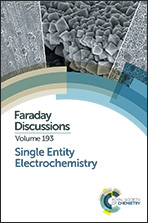Anisotropic etching of rhodium and gold as the onset of nanoparticle formation by cathodic corrosion
Abstract
Cathodic corrosion is a phenomenon in which negatively polarized metal electrodes are degraded by cathodic etching and nanoparticle formation. Though these changes are dramatic and sometimes even visible by eye, the exact mechanisms underlying cathodic corrosion are still unclear. This work aims to improve the understanding of cathodic corrosion by studying its onset on rhodium and gold electrodes, which are subjected to various constant cathodic potentials in 10 M NaOH. After this polarization, the electrodes are studied using cyclic voltammetry and scanning electron microscopy, allowing a corrosion onset potential of −1.3 V vs. NHE for rhodium and −1.6 V vs. NHE for gold to be defined. The mildness of the potentials on both metals suggests that cathodic corrosion is less extreme and more ubiquitous than expected. Furthermore, we are able to observe well-defined rectangular etch pits on rhodium. Combined with rhodium cyclic voltammetry, this indicates a strong preference for forming (100) sites during corrosion. In contrast, a (111) preference is indicated on gold by voltammetry and the presence of well-oriented quasi-octahedral nanoparticles. This different etching behavior is suggested to be caused by preferential adsorption of sodium ions to surface defects, as is confirmed by density functional theory calculations.
- This article is part of the themed collection: Single Entity Electrochemistry


 Please wait while we load your content...
Please wait while we load your content...